| کد مقاله | کد نشریه | سال انتشار | مقاله انگلیسی | نسخه تمام متن |
|---|---|---|---|---|
| 4571401 | 1629230 | 2014 | 12 صفحه PDF | دانلود رایگان |
• Unique sediment budget analysis with thousands of sediment transport measurements
• 68% of gravel and sand flux is caused by anthropogenic bed erosion and gravel supply.
• Sediment fluxes change abruptly where the river bed becomes sandy.
• Bed erosion is high in areas with shallow Tertiary sand or mining-induced subsidence.
• Transfer rate of sand and gravel to the Rhine delta did not change despite human impact.
The Rhine River is a restrained river which is intensely used for navigation. Its river bed is subject to human-induced erosion and sedimentation processes. For river management, information on the amount, type, source, transport mode and fate of the sediments moving through the Rhine is indispensable. The objective of this study was to quantify the downstream fluxes of clay, silt, sand, gravel and cobbles through the Rhine between 1991 and 2010 and to identify the sources and sinks of these sediments. This was done by analysing a unique dataset containing thousands of sediment transport measurements and by evaluating the sediment budget. The river bed of the Rhine was found to be subject to a net bed degradation of 3 mm/a between 1991 and 2010. Bed degradation has been induced by 18th–20th century river training works and nowadays is concentrated in areas with Tertiary sands close to the bed surface, in areas with mining-induced subsidence and in the gravel–sand transition zone. Sediment transport was found to be dominated by suspended clay and silt. Morphologically relevant, however, are only the sand, gravel and cobble fractions. Despite the armoured, gravely river bed, sand is the main morphological agent. Sediment loads change in the downstream direction: sand and fine gravel loads increase due to erosion of the bed, whereas coarse gravel and cobble loads decrease due to a reduced sediment mobility caused by the downstream decreasing bed slope. Approximately one third of the sand and gravel load comes from upstream (Rhenish Massif), one third is supplied by bed degradation and one third is supplied artificially by humans for bed stabilisation purposes or as substitute for natural bed-load. Slightly more than one half of the sediment was transported downstream into the North Sea Basin (Rhine Delta), a small amount was lost by abrasion, and the remainder must have been deposited in groyne fields, on floodplains or in ports. The transfer of sand, gravel and cobbles from the hinterland towards the Rhine delta equalled 0.66 Mt/a ± 26%. Despite the long history of human impact, this rate does not differ significantly from the Holocene rate of sediment transfer to the Rhine delta.
Figure optionsDownload as PowerPoint slide
Journal: CATENA - Volume 122, November 2014, Pages 91–102
